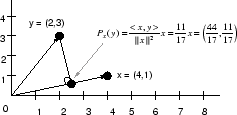NOTE: THIS DOCUMENT IS OBSOLETE, PLEASE CHECK THE NEW VERSION: "Mathematics of the Discrete Fourier Transform (DFT), with Audio Applications --- Second Edition", by Julius O. Smith III, W3K Publishing, 2007, ISBN 978-0-9745607-4-8. - Copyright © 2017-09-28 by Julius O. Smith III - Center for Computer Research in Music and Acoustics (CCRMA), Stanford University
<< Previous page TOC INDEX Next page >>
Projection
The orthogonal projection (or simply ''projection'') of
onto
is defined by
The complex scalaris called thecoefficient of projection. When projecting
onto a unit length vector
, the coefficient of projection is simply the inner product of
with
.
Motivation: The basic idea of orthogonal projection of
onto
is to ''drop a perpendicular'' from
onto
to define a new vector along
which we call the ''projection'' of
onto
. This is illustrated for
in Fig. 6.9 for
and
, in which case
Derivation: (1) Since any projection onto
must lie along the line colinear with
, write the projection as
. (2) Since by definition the projection is orthogonal to
, we must have



